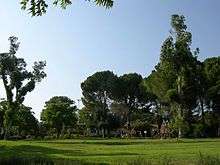Ma'ayan Baruch
| Ma'ayan Barukh | |
|---|---|
 Ma'ayan Barukh | |
| Coordinates: 33°14′27.96″N 35°36′31.68″E / 33.2411000°N 35.6088000°ECoordinates: 33°14′27.96″N 35°36′31.68″E / 33.2411000°N 35.6088000°E | |
| District | Northern |
| Council | Upper Galilee |
| Affiliation | Kibbutz Movement |
| Founded | 11 March 1947 |
| Population (2015) | 735[1] |

Ma'ayan Baruch (Hebrew: מַעְיַן בָּרוּךְ, lit. Blessed Spring) is a kibbutz in northern Israel. Located near the intersection of the Israeli, Syrian and Lebanese border, it falls under the jurisdiction of Upper Galilee Regional Council. In 2014 it had a population of 720.
History
The kibbutz was founded in March 1947 on the land of Hamara, a moshav abandoned in 1920. The founders were members of other kvutzot who had met in Kfar Giladi; members of the HaTenua HaMeuhedet youth movement, members of Habonim who immigrated to British Mandate of Palestine as Ma'apilim (illegal immigrants of Aliyah Bet), and members of a garin of pioneering soldiers from South Africa who fought in the British Army during World War II.
After the 1948 Palestine war, Ma'ayan Baruch took over part of the land belonging to the newly depopulated Palestinian village of Al-Sanbariyya.[2]
Development projects
A new neighborhood in Ma'ayan Baruch was built to attract newcomers and bring money into the kibbutz coffers in the wake of the socio-economic problems that have affected many kibbutzim since the 1980s. The newcomers are from other kibbutzim and townships in the region, as well as other parts of the country.[3]
Landmarks
A museum which holds a collection of prehistoric artifacts found in the Hula Valley, The Prehistoric Man Museum, is located on the kibbutz. The museum collection includes the skeleton of a prehistoric woman, approximately 50 years old, buried with her dog.[4][5]
Notable residents
- Menashe Kadishman (born 1932), sculptor and painter
- Amnon Shamosh, Israeli author and poet
See also
- Notes from the Frontier, an account of life on the kibbutz in the mid-1960s by American author Hugh Nissenson.
References
- ↑ "List of localities, in Alphabetical order" (PDF). Israel Central Bureau of Statistics. Retrieved 16 October 2016.
- ↑ Khalidi, Walid (1992). All That Remains:The Palestinian Villages Occupied and Depopulated by Israel in 1948. Washington D.C.: Institute for Palestine Studies. p. 494. ISBN 0-88728-224-5.
- ↑ Depression in Margaliot, Hope in Maayan Baruch Haaretz, 11 July 2008
- ↑ James Serpell, The domestic dog: its evolution, behaviour, and interactions with people, pp 10-12. Cambridge University Press, 1995.
- ↑ SJM Davis and FR Valla, Evidence for domestication of the dog 12,000 years ago in the Natufian of Israel, Nature 276, 608-610 (7 December 1978)